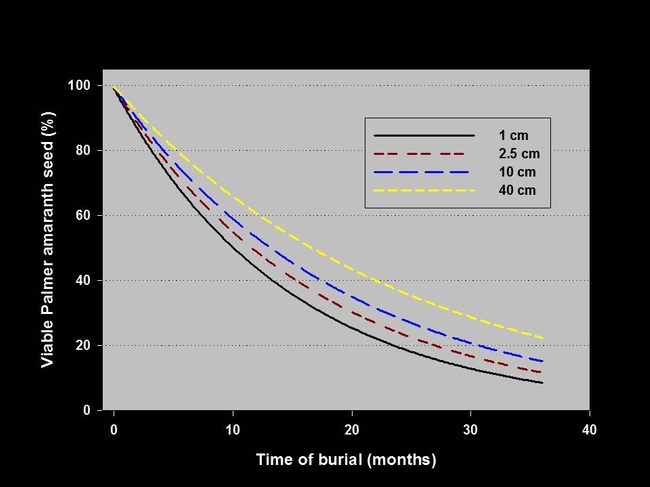Since it was first identified in 2004, glyphosate-resistant Palmer amaranth has become the most significant weedy pest of cotton in the Southeastern United States. When acceptable control is not realized, and Palmer amaranth is allowed to set seed, population densities can become quite high in infested fields. For example, research conducted by the University of Georgia indicated that Palmer amaranth seed densities exceeded 35,000 seeds per m2 in a cotton field where the glyphosate-resistant biotype had been ineffectively managed.
To combat Palmer amaranth, some cotton growers in Georgia have resumed using pre-plant deep-tillage and in-crop cultivation in fields with high weed population densities. Disturbance activities that redistribute Palmer amaranth seed from the soil surface to depths greater than 1 inch have been shown to reduce the size of the germinable seedbank (Palmer amaranth seeds are extremely small and, generally, don't possess enough energy reserves to foster seedling emergence from deeper than 1 to 2 inches). By reducing the size of the germinable seedbank, we should reduce the number of weeds that can emerge and compete with the crop, and that need to be controlled with post-emergence herbicides. The purpose of this study was to determine how long Palmer amaranth seeds can remain viable following burial.
Glyphosate-resistant and -susceptible Palmer amaranth seed were collected in October of 2007 and 2008. The seed was hand-harvested and -cleaned and divided into replicate seedlots of 100 seed each. Each seedlot was mixed with 3 cubic inches of sand. placed in nylon bags, and buried (in 2009 and 2010) in a Tifton sandy loam at depths ranging from 1/2 inch to 16 inches. Seeds were exhumed at 3 to 6 month intervals for 36 months. Seed viability was determined by counting the number of unearthed seeds that germinated at 86 F over 28 days in a controlled environment.
Initial viability (0 months of burial) of all seedlots was >96% (>96 of 100 seed germinated). There were no differences in viability between the glyphosate-resistant and -susceptible Palmer amaranth seedlots throughout the course of the study. Seed viability was affected by burial duration (viability decreased the longer seeds remained in the soil) and burial depth (seeds that were buried more deeply remained viable for a longer period of time) (Figure 1). After 12 months, seed buried at 1/2, 1, 4 and 16 inches were 44, 48, 53 and 61% viable, respectively. After 24 months of burial, Palmer amaranth viability was 19, 24, 28, and 37% at the 1/2, 1, 4, and 16 inch burial depths, respectively. By 36 months, Palmer amaranth seed viability at 16 inches (22%) was more than double that at 1/2 inch (9%), with 12 and 15% seed viability at 1 and 4 inches, respectively. Results from this study agree with others that were conducted on redroot pigweed (Amaranthus retroflexus) and tall waterhemp (Amaranthus tuberculatus).
Seeds near the soil surface will not be as persistent as those that are buried more deeply. One of the proposed methods of reducing future in-field Palmer amaranth populations is to reposition weed seeds that are near the soil surface to depths that are below the optimal emergence zone through soil inversion (i.e. moldboard plow). The current study suggests that deep burial of Palmer amaranth seeds can mitigate in-field problems in Georgia, but only if the seeds that are present at greater depths have been buried for more than 36 months.
More details about this research can be found in Sosnoskie, L.M., T.M. Webster and A.S. Culpepper. 2013. Glyphosate resistance does not affect Palmer amaranth (Amaranthus palmeri) seedbank longevity. Weed Science. 61:283-288.
Figure 1. The influence of burial duration and depth on the viability of Palmer amaranth seeds. There were no differences between glyphosate-susceptible and glyphosate-resistant populations of Palmer amaranth, therefore data were combined. The entire study was conducted twice in time (2007-2010 and 2008-2011).
